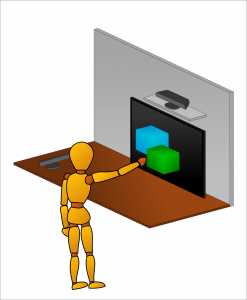Research
True Dinamic 3D
Novel technique for 3D visualization in Augmented Reality Systems.
In P.S.P.C. Lab we study how man perceives the external world through the vision system. We do this in order to foster modelling studies on visual perception and cortical functional architecture, to conceive innovative hardware and software artificial systems, and to develop novel strategies to improve the human machine interaction.
We always studied the various aspect of stereoscopic vision typical of human, and its implementation in 3D vision. In the last decade, there has been a rapidly growing interest in technologies for presenting stereoscopic 3D (S3D) imagery both for professional applications, e.g. scientific visualization, medicine and rehabilitation system, and for entertainment applications, e.g. 3D cinema and videogames. All thi sinterest could possibly lead to a new class of Immersive Reality System, so to propose to the user a new kind of Multimedia Entertainment Content. This type of content should mix the best from the two most important area of Multimedia Entertainment: films and videogames.
From the films, it should take what they are all about: perception. Movies are perception of a story, perception of an environment, of a particular moment. This new type of content should have the best CGI and special effects the movie industry can provide, allowing the user to feel to be part of the scene, in the most natural way possible.
From the videogames, this new type of content should take the most important feature videogames could provide: the interaction. Videogames let us interact with complex virtual world, nowadays even in a natural way using input device like Microsoft Kinect, Nintendo wii or Playstation Move. Using this feature, the new type of content should let us interact with the virtual objects just like we do with the real ones.
With the diffusion and availability of 3D stereo visualization systems, like active and passive TV researchers have investigated the benefits and the problems associated with the techniques used. Infact, some constraints that limit the natural use of these systems have not yet been resolved.
One above all, the possibility for the observer to move freely in front of the 3D monitor, that with the actual techniques causes a wrong depth and shape perception of virtual objects. Such distortions may also cause fatigue and visual stress while using entertainment applications, and can have serious implications in those fields where a veridical perception of the scene is required, as in augmented and immersive reality applications.
In order fix this problem we develop a novel technique for stereoscopic 3D visualization in augmented reality sistems. This technique improve the visualization of S3D environments, with the peculiarity of allowing a perfect match between the real and the displayed virtual world, solving all the limitation of actual stereoscopic 3D system and finding its best use in augmented and immersive reality applications.
We give a talk about our system as invited speaker at the Nvidia GPU Technology Conference 2014 in San Jose, CA.
We also described our technique in detail in our previous paper:
- Matteo Garibotti, Manuela Chessa, Silvio P Sabatini, Fabio Solari. “An affordable stereoscopic 3D augmented reality system for life-like interaction”. 10th European Conference on Visual Media Production (CVMP13), 6-7 November 2013, London. [doi]
- F. Solari, M. Chessa, M. Garibotti, S.P. Sabatini. (2013) “Natural perception in dynamic stereoscopic augmented reality environments”. Display 34(2), pp. 142-152 . [doi][bib]
- M. Chessa, M. Garibotti, A. Canessa, A. Gibaldi, S.P. Sabatini, F. Solari. “Veridical Perception of 3D Objects in a Dynamic Stereoscopic Augmented Reality System“. Computer Vision, Imaging and Computer Graphics. Theory and Application, G. Csurka et al. (Eds.): VISIGRAPP 2012 Revised Selected Papers, CCIS 359, pp. 274-285, 2013. [doi]
- M. Chessa, M. Garibotti, A. Canessa, A. Gibaldi, S.P. Sabatini, F. Solari. (2012) “A stereoscopic augmented reality system for the veridical perception of the 3D scene layout“. International Conference on Computer Vision Theory and Applications, VISAPP 2012, 24th-26th February 2012, Rome.
In our last paper for CVMP 2013 we described the augmented reality system we built in our lab. It’s based on a 47-inch passive 3D TV for the visualization of the 3D virtual world, and 2 Microsoft Kinects to track the user’s position and allow interaction with the virtual world.
For more information, contact Fabio Solari or Manuela Chessa

